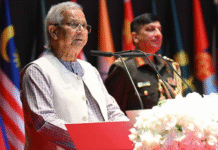A new report released by the US Department of State has cited that transnational drug trafficking organisations operate within Bangladesh with underground operations stretching from Burma to India.
Enforcements related to narcotics have reported massive leap in trafficking of synthetic drugs such as “yaba” (a mixture of caffeine and methamphetamine, sometimes with heroin) and diverted pharmaceuticals such as phensedyl (codeine-based cough syrup), mentioned the report.
Drug traffickers continue to divert precursor chemicals and chemical preparations (incorporating ephedrine, pseudoephedrine, toluene, and acetone) from Bangladeshi pharmaceutical or chemical companies’ illicit drug production, says the International Narcotics Control Strategy Report of the Bureau for International Narcotics and Law Enforcement Affairs, US Department of State.
Bangladesh has successfully engaged bilaterally with India to control the diversion of phensedyl, and Bangladeshi law enforcement agencies work closely with the Drug Enforcement Administration (DEA) to seize and disrupt illicit drugs and chemicals, said the report released on Thursday.
However Bangladesh continues to struggle to allocate sufficient resources to control precursors through consistent enforcement of existing laws despite government efforts.
The Department of Narcotics Control (DNC) issues licenses for the import, export, transport, shipment, manufacture, sale, distribution, purchase, possession, storage, or other use of controlled precursors.
The NCA implementing rules regulate the control, monitoring, and use of precursors for industrial, scientific and medical purposes through a licensing system. The DNC, however, lacks sufficient staff and equipment to detect and interdict precursors consistently.
The report said that Bangladesh has a fast growing commercial pharmaceutical industry.
It said Beximco Pharmaceuticals in August became the first Bangladeshi company to receive Federal Drug Administration (FDA) authority to export a prescription drug to the United States. “Beximco now has FDA approval for two drugs.”
Bangladesh has also established District Drug Control Committees (DDCC) to monitor and coordinate the activities among the agencies responsible for drug and precursor chemical enforcement.
Police, Customs, Rapid Action Battalion, Border Guard, and Coast Guard are empowered to detect and intercept illegal precursor chemical and drug operations.
The counterdrug unit of the Dhaka Metro Police has successfully assisted DEA in conducting investigations targeting Dhaka-based traffickers of pseudoephedrine chemical preparations.
The government of Bangladesh is committed to the implementation of the 1988 UN Convention and regional agreements regarding control of narcotic drugs, psychotropic substances and precursor chemicals.
Twenty-two of the 24 precursor chemicals listed in the 1988 UN Convention are included in the ‘Schedule of Drugs’ of Bangladesh’s Narcotics Control Act (NCA) to comply with the provisions of Article 12 of the 1988 UN Convention.
The NCA also allows financial investigations and freezing of assets derived from trafficking in drugs and precursors.
The government provides the INCB with annual estimates of Bangladesh’s legitimate use requirements for imports of the four precursors frequently used in the manufacture of amphetamine-type-stimulant (ATS).
The Directorate General of Drug Administration has developed a draft national drug policy, which was approved by the Cabinet but it has not yet been published in the gazette, in response to the threat posed by the abuse of and trafficking in pharmaceutical preparations and other drugs.
Significant amounts of heroin and ATS produced in Burma reflect the volumes of essential and precursor chemicals smuggled into the country for illicit drug production. The illicit production and export of synthetic drugs in Burma continued to increase in 2016. Burma does not have a significant chemical industry and does not manufacture ephedrine, pseudoephedrine or acetic anhydride used in synthetic drug manufacturing.
Internationally organized criminal syndicates smuggle precursor or basic chemicals into Burma through borders shared with Bangladesh, China, Laos, India and Thailand.
The precursors are then transported to heroin refineries and ATS laboratories, many located in regions of Shan State which are under the control of armed militia groups or in other areas that are lightly policed.
There are also mobile ATS laboratories along the Burma-Bangladesh border where law enforcement requires military security due to ongoing communal tensions.
Burmese authorities faced challenges in controlling the illicit import and diversion of precursor chemicals for use in production of illegal narcotics, exacerbated by the extremely porous borders, including along non-government controlled areas in Burma and India, the report mentioned.
The Burmese police continued to make significant precursor seizures in government-controlled areas such as in Mandalay, Burma’s main distribution center for precursor chemicals.
Additional international seizures of precursors destined for or synthetic drugs manufactured in Burma are a further sign of growing production.
The government of Burma has not provided estimates on the size of its licit domestic market for ephedrine or pseudoephedrine; however, Burmese officials have noted that all pseudoephedrine smuggled across the Burma-India border is destined for illicit ATS laboratories in Shan State and not the legal domestic market.
Importers of licit chemicals are required to use a Pre-Import Notification system to obtain a certificate of verification from the Burma’s Drug Enforcement Division (DED), and retailers must also apply for a certificate to transport chemicals across and within Burma’s borders.
(US Department of State)
Source: Ittefaq










